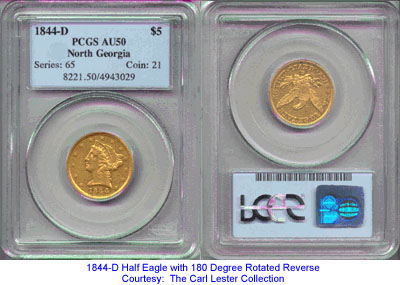

 Unique, "EB on Breast"
Unique, "EB on Breast"1787 Brasher Doubloon from
The Gold Rush Collection
The 1840s
Disagreements among the mint personnel were commonplace during this period. Part of the difficulty may have been a natural result of the problems inherent in establishing a highly technical operation in such an out-of-the-way community. Another problem was that the mint positions were considered "political plums" which were coveted by a number of persons outside the mint. It was not unusual for charges of corruption to be levied at those in positions of authority at the mint, usually motivated by self-interest. Others unabashedly campaigned for mint positions, writing letters to those of influence, especially members of Congress and state government. At that period of history, the political equilibrium was maintained between the Democrats and the Whigs. The Democrats held the presidency for the majority of the existence of the Dahlonega Mint; the Whigs' only White House occupancy during this period occurred from 1841-1845 and 1849-1853. Because they had been appointed due to their political leanings, mint personnel became especially nervous whenever they sensed that the balance of power had the potential to shift in Washington. Another cause for concern was a sense that the gold deposits were not as substantial as had been anticipated; there were pervading rumors that the mint would be shut down.
It is interesting to note that beginning in 1840, the Dahlonega Mint was legislatively authorized to coin silver. No examples of silver coinage from Dahlonega are known today. Probable causes for the lack of silver coinage include the fact that the Dahlonega Mint did not normally part the gold (and thus had little silver) and because the small size of their presses would have prevented the coinage of the larger denomination silver pieces.
One of the most interesting events in the mint's history occurred on June 10, 1840, while Coiner David Mason went to dinner. A run of half eagles was being made and upon returning Mason discovered that, "through neglect or otherwise," the bottom (reverse) die slipped a quarter turn, so that the "heads of the devices stand quartering." It is not known how many of the 1,887 half eagles minted that day had the rotated reverse, but examples are known today which have the reverse rotated 120 degrees counter-clockwise.
In April 1841 Paul Rossignol replaced Superintendent Singleton, due to the inauguration of Whig President William Henry Harrison.

Coincidentally, the amount of bullion being deposited increased significantly. Rossignol, from Habersham County, and of French descent, was 53 years old when he became superintendent. He seemed somewhat out of place in the frontier community. Continuing concerns about the possibility of the mint's closure plagued Rossignol. He also incurred the wrath of depositors who were not promptly paid; some had to wait for over a month for their Dahlonega pieces. The increase in deposits, spurred on by a very rich strike at the O'Bar Mine in May 1842, caused a strain on the ability of the mint to respond to the increased demand. Although Rossignol was accused of profiting from his office, stemming from the delay in paying depositors, a close examination of the facts revealed that his worst "crime" was being a foreigner.
 In June 1843, James Cooper, who ran the mint until 1849, replaced Rossignol. Cooper, the first superintendent to actually live in the mint building, was a West Point graduate and ran the facility with military bearing. Upon assuming the new position, he noted that the people were "clamorous for coin" and he did his part in satisfying the demand.
In June 1843, James Cooper, who ran the mint until 1849, replaced Rossignol. Cooper, the first superintendent to actually live in the mint building, was a West Point graduate and ran the facility with military bearing. Upon assuming the new position, he noted that the people were "clamorous for coin" and he did his part in satisfying the demand.
Although payments to depositors had been anything but regular during the preceding period, Cooper instituted a schedule whereby mint customers were paid no later than three working days after making the deposit. Cooper's tenure was also marked by harmony among the mint personnel and good relations with the people of Dahlonega. During this period, both the quantity and quality of the coins were high. In less than six and one half years, Cooper presided over the striking of nearly 44% of the Dahlonega Mint's total coinage output.
Cooper was not without his problems, however. Although there were newspaper reports in 1844 that Dahlonega quarter eagles had been counterfeited, no further mention of the problem is found in mint correspondence. Cooper also released some anomalous coins, as at least one 1844-D half eagle is known today with a reverse rotated 180 degrees.

Even the meticulous Cooper was not immune from those after his job. One of them was former Superintendent Joseph Singleton, who levied unfounded charges against Superintendent Cooper. The charges did not stick, but Cooper, a Democrat, could not survive the election of Whig Zachary Taylor to the presidency in 1848.
 One of Superintendent Cooper's last contributions included the first minting of gold dollars in July 1849.
One of Superintendent Cooper's last contributions included the first minting of gold dollars in July 1849.
The production of these tiny coins was no small accomplishment for the Dahlonega Mint personnel.
In October 1849, Anderson Redding, formerly keeper of the state penitentiary, became the new superintendent of the Dahlonega Mint. Secretary of War George Crawford described him as "a full-brained, round-headed, stout-built, kind-hearted, and high-mettled Christian man." He had continual problems with bookkeeping, some of which were brought about because, for the first time in her history, the Dahlonega Mint had considerable amounts of silver with which to contend.
